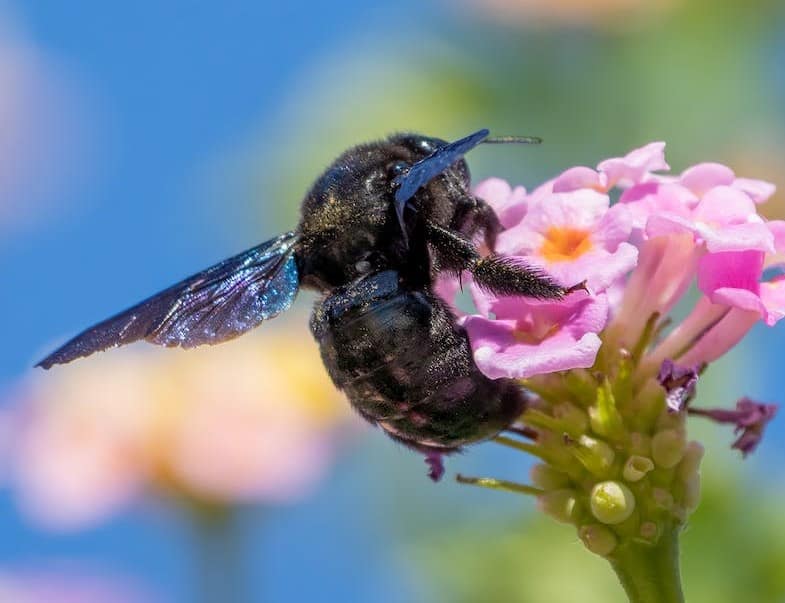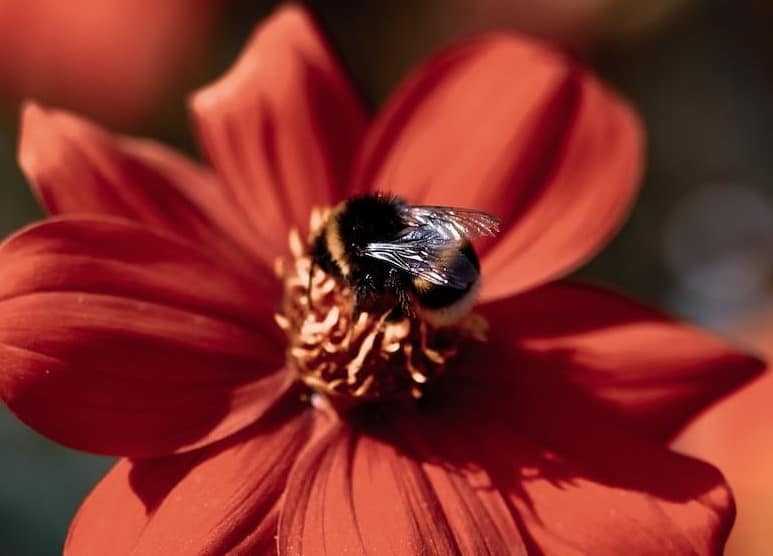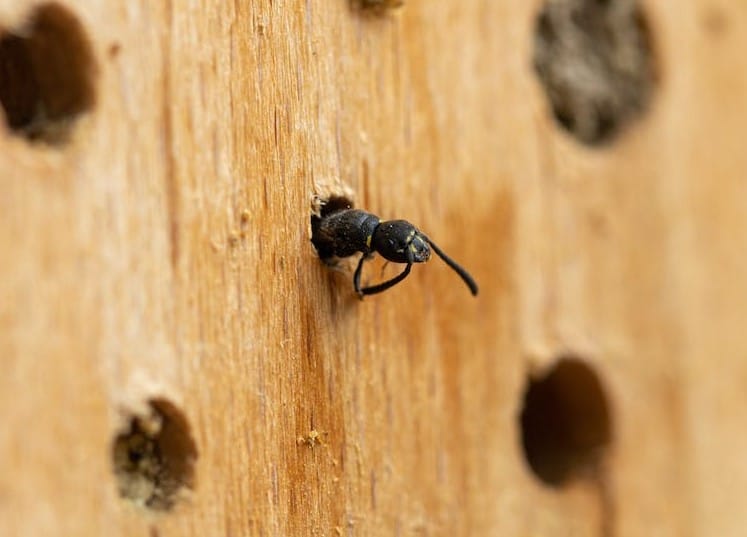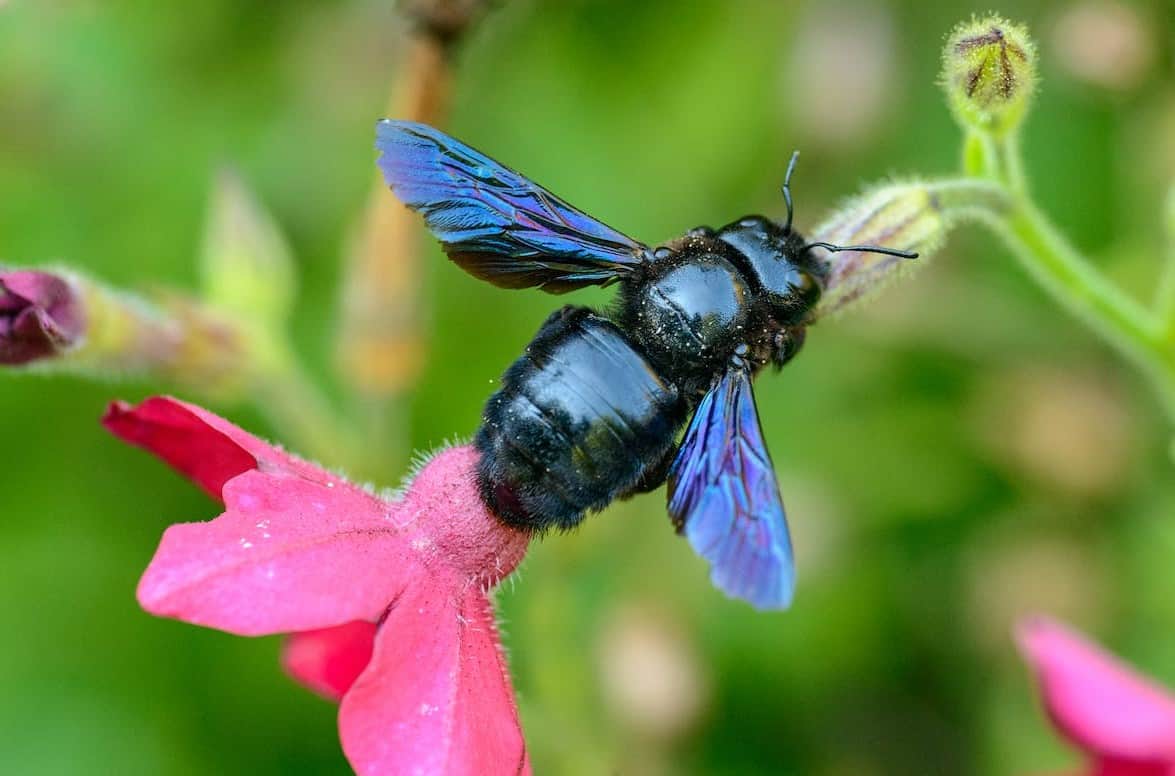A Blue Carpenter Bee would definitely catch your attention during the spring and summer days with its distinct coloring and large size.
This bee loves buzzing around the house. Yet, some of the same species could be seen burrowing in wooden structures of your house to build their nests.
Despite not being able to produce honey, these bees play important roles in our ecosystem as pollinators. Farmers, gardeners, and those in the agribusiness benefit from the pollination services that blue carpenter bees could provide.
In this blog post, we will take a closer look at the blue carpenter bee.
Whether you’re a homeowner, a gardener, or simply someone who’s curious about these fascinating insects, this article will provide valuable information on blue carpenter bees.

What is a Blue Carpenter Bee?
A Blue Carpenter Bee (Xylocopa caerulea) is a large bee belonging to the order Hymenoptera.
This bee specie is mostly found in India, Southeast Asia, and Southern China, although a few of them has made their way to the Americas. There are a few species widely distributed in Europe.
These bees are known to prefer wooded areas and are often found around homes, wooden buildings, and other man-made structures that are made of wood.
Physical Characteristics
One distinct characteristic of this bee species is that it can grow up to an inch long. It is also quite distinguishable from other bees by its blue-black coloring. The bee actually has black bodies with thorax that are covered with light blue hairs.
The combination of the blue hairs on a black background gives this bee its striking blue color. The bee’s abdomen is also covered with blue hairs but of a finer texture.
The female blue carpenter bees have slightly larger and wider heads compared to their male counterparts. Females would have white markings on their heads, and males would have yellow ones. The females have stingers, while the males do not.

Behavior
Blue carpenter bees are solitary insects. A female blue carpenter bee carries all the burden of burrowing into the wood and building its nest. Once she has created her nest, she will lay her eggs. She is also tasked with foraging food for herself and larvae.
Unlike honey bees that produce honey at a commercial level, the female blue bees, living solitary lives, are incapable of producing raw honey.
A male blue carpenter bee does not help in building the nest. However, he will be around to defend the female’s home from potential threats.
The life cycle of blue carpenter bees typically involves winter dormancy, followed by mating and nesting in the spring and summer.
Just like other carpenter bees, only female blue carpenter bees have stingers. However, they are not known to be aggressive and will typically only sting if they feel threatened.
Blue Carpenter Bees vs. Bumble Bees
Blue carpenter bees are relatively large species of bees, just like bumble bees of average size. However, the former has a thinner coat, making them look shinier compared to the latter.
Blue bees can be identified by their large size (about 1 inch long) and shiny, metallic blue-black color. They resemble bumblebees in appearance but can be distinguished by their shiny, almost iridescent color. They also have a distinctively large, black abdomen and a yellow or white mark on the face.
Blue carpenter bees lead solitary lives, while bumble bees are social insects that live in colonies. The carpenter bees are most often found hovering around wood structures, while bumble bees are often found foraging for nectar and pollen on flowers.

Environmental Impact
Blue carpenter bees are important pollinators and play a crucial role in the ecosystem.
Besides this beneficial impact that these bees contribute to the environment, there is nothing much as carpenter bees do not produce honey. These bees are not considered pests and would not be a bother when left alone.
On the negative side, blue carpenter bees can cause damage to wooden structures. Houses, decks, and fences would fall victim to these bees as they burrow into the wood to create nests. The female bees gnaw on the wood with their mandibles but do not eat them. This can lead to structural weakening and even collapse of the affected wood.
Additionally, their nesting habits can also cause unsightly holes and sawdust in the wood. When you see signs that there are bees living in your walls, it might be time to take some appropriate action.
Another potential negative impact is that their nesting habits can affect human health, as their nests can attract other insects and pests, such as termites, ants, rodents, and beetles.

Conclusion
It’s important to note that these bees do not cause harm to people, so there is no need to kill them. It is best to leave them alone.
In some states in the US, it might be illegal to kill certain bees, such as the Blue Carpenter Bee, without a permit. Check with your local authorities before taking any action.
Handling them personally is also not advised. Contact a local beekeeper or an insect exterminator when necessary.
Overall, the impact of blue carpenter bees on humans and the environment is generally considered to be minor. It is important to understand that they are a natural part of the ecosystem and play an important role in pollination.
In some cases, the damage they cause to wooden structures may require management or control measures. If you have a wood structure that is being damaged by blue carpenter bees, there are natural ways to control and manage their population, such as by sealing off potential nesting sites.
Blue carpenter bees are an important part of the ecosystem, and their populations should only be managed or controlled when necessary to protect human health or property.

The Blue Carpenter Bee, scientifically known as Xylocopa caerulea, is a notable species found primarily in India, Southeast Asia, and Southern China, with some presence in the Americas and Europe. These large bees, reaching up to an inch in length, are distinctive due to their blue-black appearance, featuring light blue hairs covering their bodies. Notably, females possess stingers, while males do not, and differences in head markings help distinguish the two genders. These bees are commonly spotted in wooded areas and around wooden structures.
This insightful article provides a comprehensive overview of the Blue Carpenter Bee, offering valuable information for nature enthusiasts and homeowners alike. From their distinct physical characteristics to their solitary behavior, the piece provides a fascinating glimpse into the world of these bees. The emphasis on coexistence and environmental impact is commendable, highlighting the significance of these bees as pollinators. Moreover, the article wisely advises against harming them and suggests seeking professional assistance when needed. It’s an educational read that promotes both understanding and responsible interaction with nature.